NORTH WALES COAST
RAILWAY: NOTICE BOARD
Rheilffordd arfordir gogledd Cymru: Hysbysfwrdd
18 July 2011
 Last issue
Last issue Archive
Archive Contributions and comments are encouraged: see the Contributions Page
This site is dedicated to all our regular contributors and supporters, and especially the rail staff of North Wales.
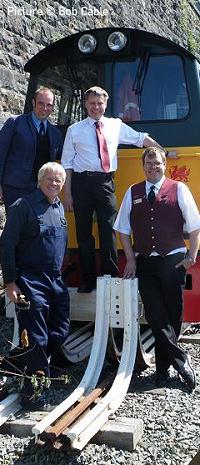
Forthcoming events
July 2011
Tuesday 26 July Conwy Valley Steam: Railway Touring Company, 'The Welsh Mountaineer' Preston - Blaenau Ffestiniog.
August 2011
Note: The Railway Touring Company tours in August can also be booked together as a week's package which also includes steam trips on the 'Cumbrian Mountain Express' and 'The Cambrian'.
Sunday 7 August Steam on the Coast: 'The North Wales Coast Express' Railway Touring Company Liverpool and Chester to Colwyn Bay, Llandudno, Bangor and Holyhead. Hauled throughout, by one of 6100 Royal Scot, 6201 Princess Elizabeth, or 60019 Bittern.
Tuesday 9 August Conwy Valley Steam: Railway Touring Company, 'The Welsh Mountaineer' Preston - Blaenau Ffestiniog.
Sunday 14 August Steam on the Coast: 'The North Wales Coast Express' Railway Touring Company Liverpool and Chester to Colwyn Bay, Llandudno, Bangor and Holyhead. Hauled throughout, by one of 6100 Royal Scot, 6201 Princess Elizabeth, or 60019 Bittern.
Sunday 14 August Excursion Compass Tours - Holyhead (dep. 07:30) to Bath or Salisbury, 'Western Cathedrals Express'
Saturday 20 August Steam on the Coast: Vintage Trains Tyseley - Llandudno and return with 5043.
Sunday 21 August Steam on the Coast: 'The North Wales Coast Express' Railway Touring Company Liverpool and Chester to Colwyn Bay, Llandudno, Bangor and Holyhead. Hauled throughout, by one of 6100 Royal Scot, 6201 Princess Elizabeth, or 60019 Bittern.
Tuesday 23 August Conwy Valley Steam: Railway Touring Company, 'The Welsh Mountaineer' Preston - Blaenau Ffestiniog.
27, 28 & 29 August –August Bank Holiday Weekend Welsh Highland Heritage Railway, Porthmadog – Fun Whatever The Weather!
'Who cares if it rains over the Bank Holiday? We’ve organised a special fun weekend, including chance to win a prize if you find the Welsh Dragons hiding in the Engine Sheds.'
See the Calendar page for more details and later dates.
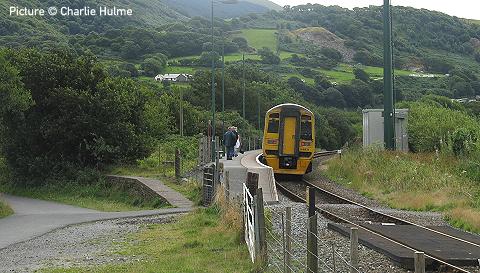
A recent view of 158 831 at Morfa Mawddach, ex-Barmouth Junction. Compare the views below (Charlie Hulme). The Class 158 refurbishment programme is proceeding: 158 820 is the fourth to be completed and the the next may be 158 841.
No 'hot news' from the weekend this time as we are currently visiting the land of song and ERTMS.- Back to normal with a catch-up next week.- Charlie
Halcyon Days on the Cambrian Coast
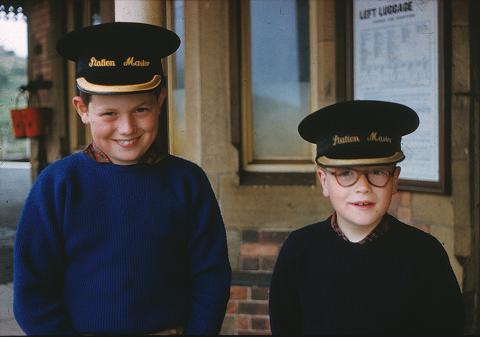
For those of us who were children in the 1950s, memories of the hard conditions of life at that time tend to be eclipsed by fond nostalgia for sunny seaside holidays, which for many people also meant long rides behind steam traction. In those days, too, the people of the railway had a much more open attitude to the public than the present highly-regulated regime: necessary, of course, because of the faster, quieter trains and the different general outlook on life and personal responsibility that prevails today.
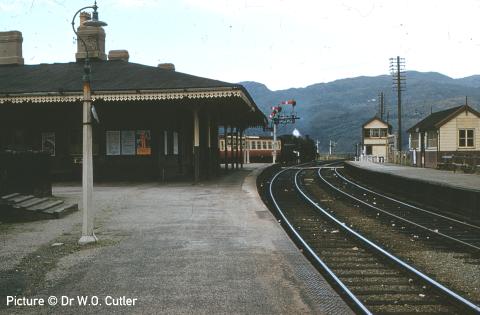
We were delighted to receive these superb pictures from Tim Cutler, who writes: 'The photographs were taken in the summers of 1957, 1958 and 1959 by my father, Dr. W. O. Cutler (1914 - 2007). As a family, from the Manchester area at that time, we used to holiday at a farmhouse just outside Dyffryn Ardudwy on the Cambrian Coast, and a relative of the farmer was the station master at Barmouth Junction, the station seen in these pictures, south of Barmouth Bridge, where the line from Ruabon (closed in 1965) joined the Cambrian Coast route (the station is now reduced to a tiny unstaffed halt called Morfa Mawddach).
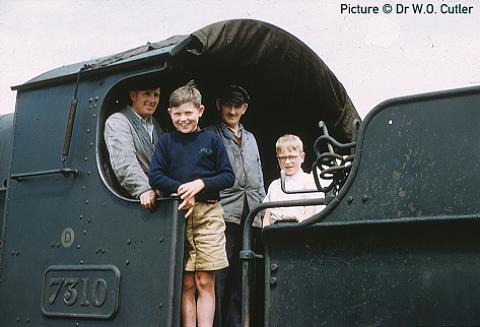
'This gentleman actually got my brother and myself on to the footplate of a locomotive, and I can honestly say that I "pulled the lever" and drove the loco over Barmouth Bridge. I have related that story to many people over the years; I'm sure that they have thought I was 'telling fibs', but a couple of years ago my wife and I actually met up with the daughter of the Station Master. When I told her of these people's doubts, she was quite adamant that my story was true as she was there at that time!'
The loco in the picture above, 7310, is one of the ex-Great Western Railway 2-6-0s which were regulars on the line. Note the tarpaulin on the roof, held by springs to the cab handrail: should it rain (yes, it sometimes did even in 1950s summers) this could be pulled back and attached to the tender to provide some protection for the crew.
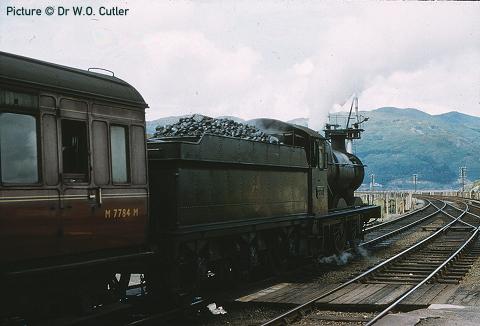
Above, GWR 0-6-0 'Collett Goods' 2237 takes a train from the Machynlleth direction out on to Barmouth Bridge in July 1958. The coach, M 7784 M, is a corridor vehicle built by the LMS railway in the 1920s, although the Cambrian lines were part of the Western Region until 1963.
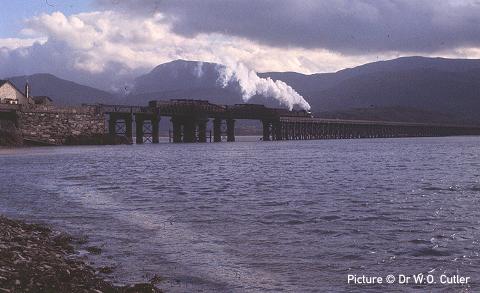
The view from Barmouth across the viaduct, with the Cader Idris massif on the skyline, is indistinguishable from the same scene over 50 years later.
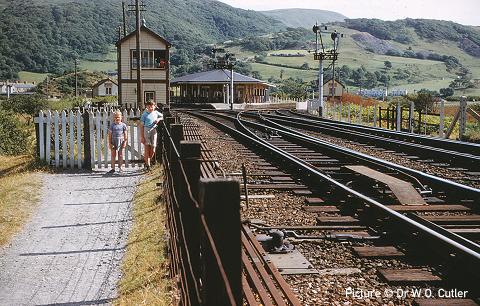
Looking at Barmouth Junction station from the path which runs across the bridge. The gate, or a replica, is still in position today, but of the station and its buildings, signals and tracks, only a single line curving round to the right and a part of the platform remains. (See the heading picture.) There was a triangle of lines here, but there was no platform on the direct link between the Ruabon and Machynlleth routes.
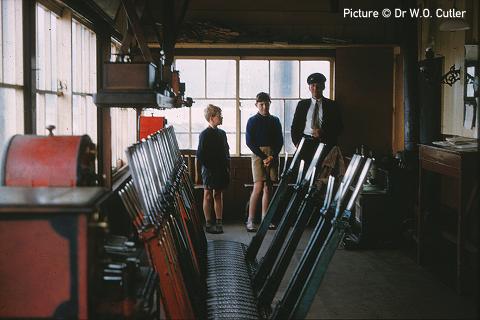
Inside Barmouth Junction signalbox, a standard Great Western Railway design which must have replaced one or more Cambrian Railways boxes at some stage. The red box with curved top to the left is the token instrument for single line working.
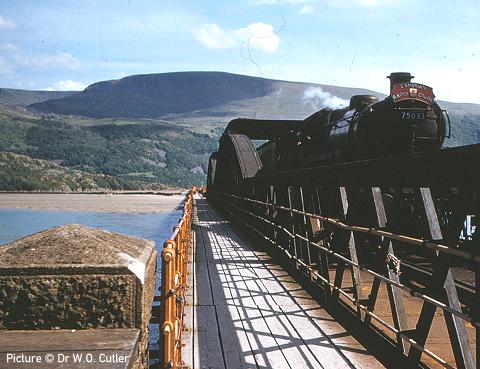
Crossing the swing spans of Barmouth Bridge in the afternoon of a sunny July 1957 day is the 'Cambrian Radio Cruise' hauled by BR standard 4-6-0 75033. The history of the these 'Land Cruise' trains, which ran around various circular routes in the summer is complex, but we think this train would have started from Llandudno and run via Rhyl, Corwen and Ruabon to Barmouth, where the passengers had a break for sightseeing, before it returned north to complete the circuit via Barmouth, Porthmadog and Afon Wen. The fare for the circuit was just over £1. For much more about this train and its working, visit our 21 June 2010 special issue.
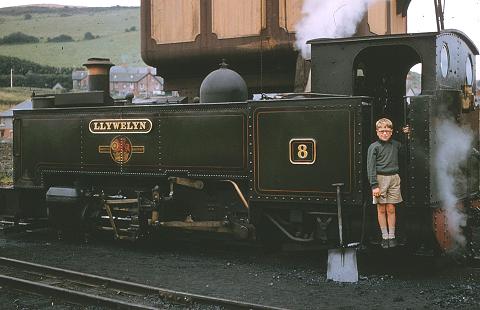
Finally, a visit to the Vale of Rheidol Railway in October 1958, with loco no. 8 Llywelyn looking good in full British Railways lined green express livery.
The new line at Minffordd - report by Ken Robinson
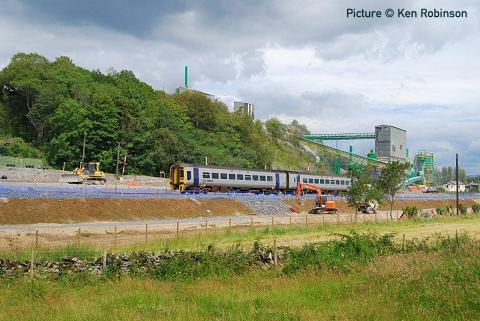
A view of the recent re-aligning of the Cambrian Coast line at Minffordd Quarry to allow for the new road, taken with permission from a nearby farmer's field on 1 July. Seen in the picture, right to left: New channel for the drainage ditch, on previously agricultural land, by the orange machine; new railway alignment, with an unidentified class 158 on the 12:56 Machynlleth to Pwllheli train - previously ditch and agricultural land; new road (Porthmadog/Minffordd by-pass) where the yellow machine is working, previously the railway. Inner quarry road - in front of the trees at the far end - no change there.
Blaenau to Caernarfon non-stop - by Bob Cable
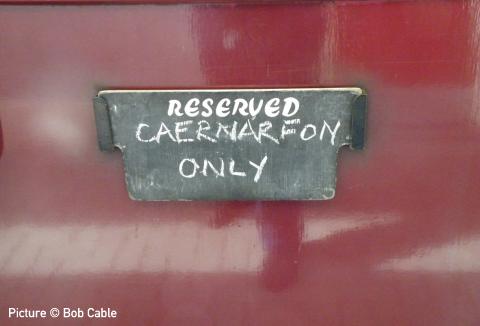
This feature will appear in the book WHR Renaissance: the Story of the Restoration of the Welsh Highland Railway from Caernarfon to Porthmadog to be published as a limited edition in April 2012. We include it here by kind permission of the publisher, Adlestrop Press.
The Ffestiniog Railway has long been well known for its ability to field extraordinary galas and special events. With the completion of the Welsh Highland Railway, a whole new raft of possibilities have opened up, as witnessed by the glorious 'Snowdonian' in March 2011. However the FR family has also been adept at quietly doing the extraordinary with little or no publicity. Thus it was at the 'Spring Thing' event in 2011 that the eagle-eyed might have noticed a ‘NONSTOP’ run from Blaenau Ffestiniog to Caernarfon, inserted almost apologetically on Sunday 1 May. This train would surely be notable as the longest non-stop run ever achieved on a preserved railway in Britain.
Perhaps because no one quite believed it could be done, or because it had to be diesel-hauled (even the FR has yet to perfect 2ft gauge water troughs), the train ran with little fanfare. So it was that FR Funkey-built diesel Vale of Ffestiniog set off with seven carriages at the unusually early hour of 08.40, 10 minutes late as it happened, for what was an unremarkable run to Blaenau.
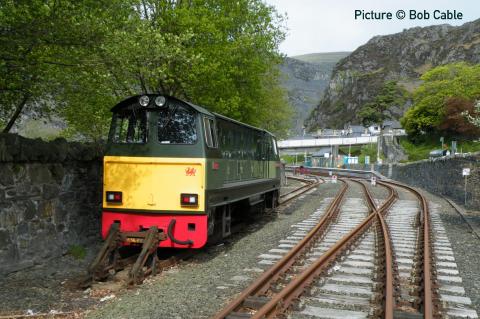
However once at Blaenau, the Vale and her crew of two, Messrs Bob Cable and David Davies, crept off round the corner, out of sight, to ‘kiss’ the buffer stops (above). The Vale would truly become the only engine to have covered the combined railway every inch of the way! Departure time was set at 10:05 and departure was (almost) deliberately a little late at 10:08. Now, as those in the know will appreciate, the FR, and now the WHR, are not well set up for non-stop working, as train crews operate all the token and staff arrangements except at Rhiw Goch and Harbour station. A 'mobile' signalman in the person of Mike Baker, who had ably co-ordinated the arrangements for the train, would race (carefully by road) from station to station wherever the train was not scheduled to cross another or where there was no resident signalman.
Thus, six minutes after departure, the train inched through Tanygrisiau, and off at a very gentle pace to allow the signalman to get ahead of the train. Indeed the order of the day was for the drivers to be patient and to roll along gently. Giving in to temptation and romping though any sections would lead to a wait in a loop somewhere and ruin the day.
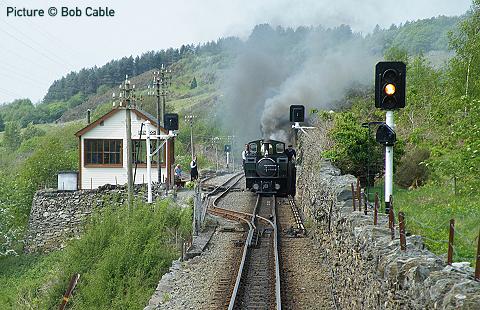
Tan-y-Bwlch was passed at 10:36, five minutes later than the working timetable, before continuing onward through the woods to Rhiw Goch (above - seen from the co-pilot's seat). Here the 'Express' comfortably passed the 10:15 from Porthmadog to Blaenau behind the Earl of Merionydd. Onward past Penrhyn, the train slipped passed Minffordd, still 5 late, with the General Manager manning the signalling arrangements. Swinging round Boston Lodge curve the down home was seen to be clear but the discs beyond, controlling the points to the WHR, were firmly 'on' as they should be. After passing the home, the signal could be returned to danger and the points set for the WHR, so the train edged forward gently towards Porthmadog. When the WHR Points disc signal cleared, the engine swung on to the WHR, passing Harbour station 58 minutes after leaving Blaenau.
Exchanging the token for the Pont Croesor 'staff', the ensemble rumbled at the prescribed 5mph over Britannia Bridge, round the back of Wilkinsons, over Snowdon Street, and finally we clattered over the Cambrian Coast line at Cae Pawb. The Welsh Highland Heritage Railway were in fine form, with no less than three engines saluting the train with a chorus of whistling and waving, responded to with much blowing of the Vale's horn, and waving in return. Who says there is any animosity between the two organisations? Due to an anomaly in the working timetable the train was now two minutes early, so progress was pedestrian to spill a little time. Mike Baker appeared for the third time at Pont Croesor, activating the crossing with the staff before exchanging it with the loco crew.
From here we have to admit that there was a little cheating going on, or at least those involved were making use of technology that was unavailable to our forebears. A mobile call from Control warned the crew that the 10:00 from Caernarfon was running a bit late and that an arrival at Beddgelert at 11:42 was needed to guarantee a non-stop transit. A splendid dawdle ensued, hardly a hardship on a wonderful sunny day with the mountains of Snowdonia filling the windows ahead of the train. Having given the passengers plenty of time to enjoy the delights of the Aberglaslyn Pass, the train nosed rather tentatively into Beddgelert. With no mobile signal hereabouts were we still too early? There were lots of people on the platform but was No. 87 round the corner out of sight? Happily the 10.00 from Caernarfon was comfortably in the platform, and the special could surge away up into Beddgelert Forest, with this potential obstacle behind it.
The next excitement was whether or not the Vale would overheat on the 1 in 40 climb. Due for a new radiator last winter, an unfulfilled ambition, the engine had given trouble though much of 2010 with overheating, although in fairness this was often when double-heading with the small Beyer-Garratt K1. This loco did not have a good year in 2010 either, and the practice of pushing a sulking K1 in front, as well as hauling nine carriages, became known amongst some diesel drivers as 'pushing the pram' up the hill! No wonder the Vale was often nearly on the boil. Careful handling however got us to the top of the hill this time, with the temperature gauge just hovering at the 100 degrees mark.
Our mobile signalman offered appropriate token exchanges, to see the train past Rhyd Ddu, and Waunfawr for the fifth and final time. Still, the train was forced to amble, with the prospect in mind of crossing the 12:30 from Caernarfon at Dinas. Suddenly, just before Tryfan Junction, a call from Control confirmed that the Up train was safely in the loop at Dinas.
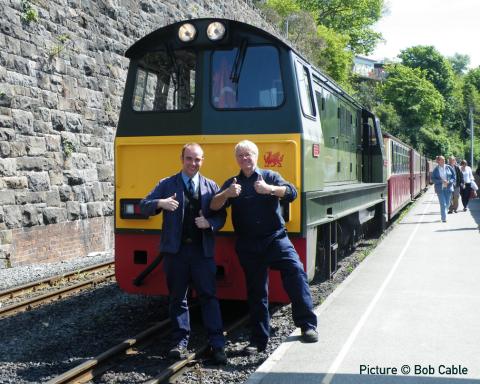
The Vale was able to surge away with her train. The 'Express' now rattled down the bank, past Plas Bodaden, exchanged staffs with the crew of the waiting 138 at Dinas, and had a burst of line speed running down the bank into Caernarfon. Clattering out from under St Helen's Road Bridge as Caernarfon Castle hove into sight the train, now checked to the required 5mph, drew to a stand in Caernarfon Station (above), exactly on schedule at 13.00. With just a tad under 40 miles under its belt, the Non-stop Special had indeed done it non-stop in a time of 2 hours and 52 minutes.
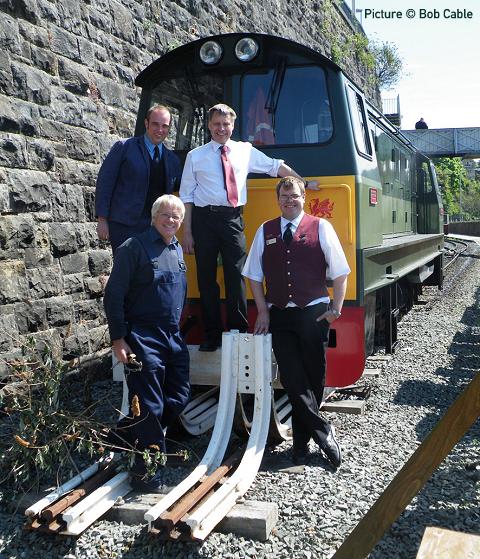
After a few photos for the record, the crew drew the Vale forward to 'kiss' the stops at Caernarfon. Every inch of the railway had been covered. In the same time we might have gone from Paddington to Port Talbot or Euston nearly to Penrith, but we wouldn’t have had so much fun. Was it the longest non-stop run, in terms of time that is, anywhere on Britain’s railways that day or month or even year? The FR and WHR can be proud to have set a time and distance record for any non-stop run on a preserved railway. Who will beat it?
Changes at Wrexham - Report by George Jones
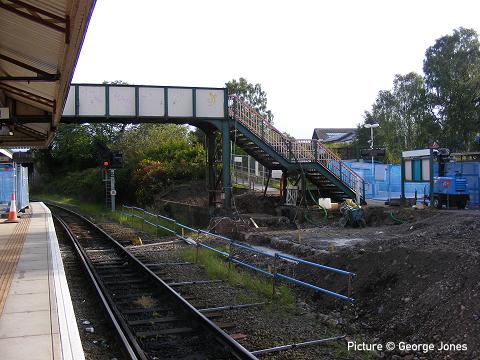
Work is now under way at Wrexham General station for the provision of the new disabled access to platform 4 (the Bidston Line - formerly Wrexham Exchange) seen to the right of the picture. The contractors, Osborne, have now closed the footbridge extension to platform 4 from platform 2/3 overbridge, and access is directed via the road bridge and ramp, as seen in the picture taken on 11 July. Passengers southbound from Bidston wishing to connect for the southbound train might wish to know about this, as these connections can be tight - arrive xx.28 and depart xx.38 on most trains. Northbound connections are more generous for those coming from the south.
The diggings reveal evidence of previous structures from the days when there were two separate stations - one controlled by the Great Western Railway and the other by the Great Central (later the LNER.) Older Wrexham inhabitants still refer to the Bidston line as the GC (or maybe North Eastern) although the habit is dying out.
The final form of the new facility will be of interest justifying the £1m price tag which has been quoted. (or was it £1.4m?) At least a great deal of overgrown vegetation has been cleared - note the clip-on safety fencing joined to the line in platform 3 which is now required for this kind of work alongside running lines.
Llanbadarn Level Crossing
The automatic half-barrier level crossing on the Cambrian main line at Llanbadarn, just outside Aberystwyth, adjacent to another one which is on the Vale of Rheidol narrow-gauge line, has had its problems in the past, and here it is again in a recent Railway Accident Investigation Board preliminary report:
The RAIB is carrying out an
investigation into an incident which occurred at the level crossing at
Llanbadarn, near Aberystwyth, Dyfed, on the railway between Aberystwyth
and Machynlleth, on Sunday 19 June 2011.
At 21:52 hrs on 19 June, the late-running 21:30 hrs Aberystwyth to Machynlleth train passed over the crossing while the barriers were raised, and came to a stop with the front of the train about 40 metres beyond the crossing. There were no road vehicles or pedestrians on the crossing at the time.
Llanbadarn level crossing, which is on the A4120 Heol y Bont, is an automatic half-barrier crossing, whose operation is monitored locally (ABCL). For trains travelling from Aberystwyth towards Machynlleth, operation of the crossing is normally initiated by the driver pressing a plunger on the platform at Aberystwyth station shortly before the train is due to depart. There is a driver’s crossing indicator, positioned a short distance on the approach side of the crossing, which normally displays a flashing red light. This changes to a flashing white light when the crossing equipment has operated normally, i.e. the red road traffic signals are showing and the barriers have lowered. Passenger trains are permitted to pass over the crossing at 65 km/h (40 mph).
This section of the national rail network is equipped with the European Rail Traffic Management System (ERTMS), which was commissioned in March 2011, and replaced the previous signalling system on the Cambrian lines between Shrewsbury, Aberystwyth and Pwllheli. The status of automatic level crossings is not indicated on the driver’s cab display.
The RAIB’s preliminary examination has found that the operation of the crossing had been initiated at Aberystwyth by the train driver, but that by the time the train reached it the crossing had ‘'timed out' and re-opened to road traffic.
The investigation will examine the sequence of events leading up to the incident, the risk associated with the level crossing, the history of previous incidents involving train driver error at this location, and the factors that influenced the behaviour of the driver on the approach to the crossing.
At 21:52 hrs on 19 June, the late-running 21:30 hrs Aberystwyth to Machynlleth train passed over the crossing while the barriers were raised, and came to a stop with the front of the train about 40 metres beyond the crossing. There were no road vehicles or pedestrians on the crossing at the time.
Llanbadarn level crossing, which is on the A4120 Heol y Bont, is an automatic half-barrier crossing, whose operation is monitored locally (ABCL). For trains travelling from Aberystwyth towards Machynlleth, operation of the crossing is normally initiated by the driver pressing a plunger on the platform at Aberystwyth station shortly before the train is due to depart. There is a driver’s crossing indicator, positioned a short distance on the approach side of the crossing, which normally displays a flashing red light. This changes to a flashing white light when the crossing equipment has operated normally, i.e. the red road traffic signals are showing and the barriers have lowered. Passenger trains are permitted to pass over the crossing at 65 km/h (40 mph).
This section of the national rail network is equipped with the European Rail Traffic Management System (ERTMS), which was commissioned in March 2011, and replaced the previous signalling system on the Cambrian lines between Shrewsbury, Aberystwyth and Pwllheli. The status of automatic level crossings is not indicated on the driver’s cab display.
The RAIB’s preliminary examination has found that the operation of the crossing had been initiated at Aberystwyth by the train driver, but that by the time the train reached it the crossing had ‘'timed out' and re-opened to road traffic.
The investigation will examine the sequence of events leading up to the incident, the risk associated with the level crossing, the history of previous incidents involving train driver error at this location, and the factors that influenced the behaviour of the driver on the approach to the crossing.
The last mishap, in 2008 involved a train (158 831) heading towards Aberystwyth, and a 'near miss' - the train stopping 2 metres short of a road tanker which was crossing. The report on that incident said that 'Since 2001 there have been three previous occasions recorded when a train ran through Llanbadarn level crossing in an uncontrolled manner when the barriers were not lowered, on 17 August 2001, 8 November 2005, and 24 April 2007. None resulted in any collision with a road vehicle, or any injury or damage. The 2005 incident involved an up train, and the other two down trains.'
Mostyn Dock visitor - report by Dave Sallery
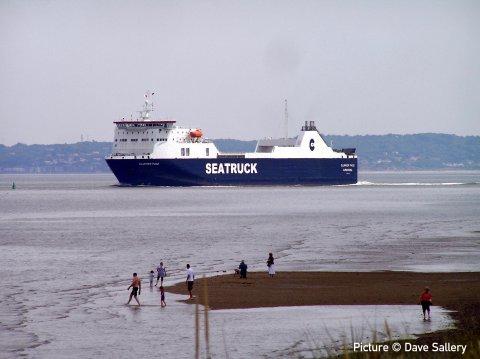
M.V. Clipper Pace, normally used on the Seatruck service from Liverpool to Dublin, paid a visit to Mostyn on 3 July and departed on the 4th; the ro-ro ship is seen here at Talacre. It is understood this vessel will be used in the future to bring in wind turbine parts.
North Wales Coast home page Archive Previous Noticeboard